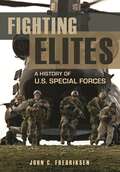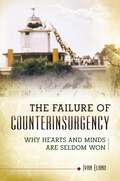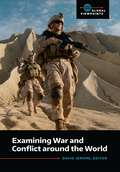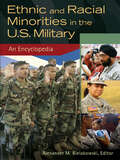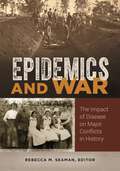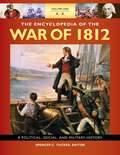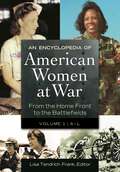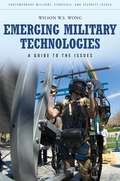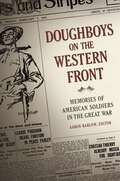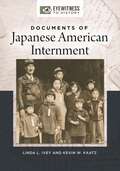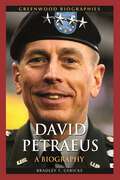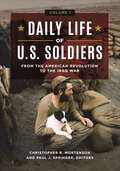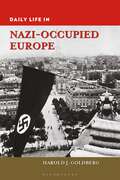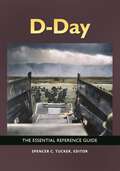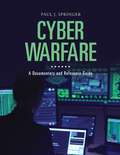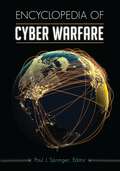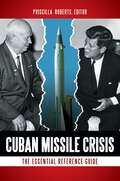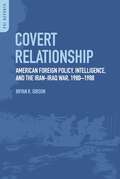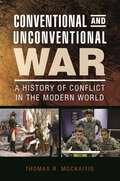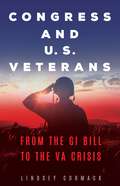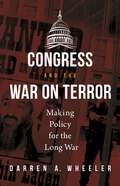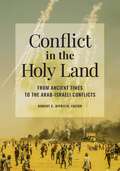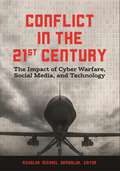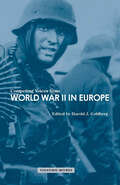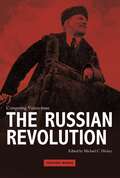- Table View
- List View
Fighting Elites: A History of U.S. Special Forces
by John C. FredriksenFrom Army Rangers to Green Berets to the U.S. Navy SEAL team that killed Osama bin Laden, this book explains what makes Special Forces "special," covering the rich and varied history of elite formations in American military history and describing their recruitment, intense training, and equipment in depth.Most civilians have only a vague idea of what the U.S. Special Forces are all about—who they are, how they differ from our "normal" military forces, what they've accomplished throughout our history, and how they operate today. Fighting Elites: A History of U.S. Special Forces examines the rich and varied history of U.S. Special Forces, identifies their contributions to specific conflicts from colonial times forward, and highlights their present operational excellence.In this first-ever reference guide to U.S. Special Forces, military historian John C. Fredriksen provides a carefully balanced presentation, describing all units in their own detailed section that discusses their origins, recruitment, training, tactics, and equipment, and defining military engagements, if known. The text also contains 20 biographical entries of noted personalities associated with special purpose activities.
The Failure of Counterinsurgency: Why Hearts and Minds Are Seldom Won (Praeger Security International)
by Ivan ElandThis book examines the implications of counterinsurgency warfare for U.S. defense policy and makes the compelling argument that the United States' default position on counterinsurgency wars should be to avoid them.Given the unsatisfactory outcomes of the counterinsurgency (COIN) wars in Afghanistan and Iraq, the U.S. military is now in a heated debate over whether wars involving COIN operations are worth fighting. This book provides a comprehensive analysis of the effectiveness of COIN through key historic episodes and concludes that the answer is an emphatic "no," based on a dominant record of U.S. military or political failure, and inconsistency in the reasons for the rare cases of success. The author also examines the implications of his findings for U.S. foreign policy, defense policy, and future weapons procurement.
Examining War and Conflict around the World (Global Viewpoints)
by David JeromeThis volume addresses 10 issues pertaining to war and conflict, such as ethics of war, national security, and refugees, and examines how countries around the world are facing these issues.To truly explore war and conflict, one must consider why the peoples and the leaders of the world behave the way that they do toward one another. For instance, why are refugees, in a variety of circumstances, treated so inhumanely in times of conflict and unrest through no fault of their own? How are women and those in the LGBTQ community treated in terms of service to their country? Examining War and Conflict around World includes ten chapters, each addressing a specific issue relating to war and conflict as it pertains to a variety of countries, including anti-Americanism, military robots and drones, nuclear weapons and proliferation, and torture. Each chapter begins with an introduction to the issue. Following the chapter introduction, each chapter highlights that issue in eight countries. Chapters provide historical perspective, but the book addresses each of the issues in a contemporary context. This work will provide an overview for all readers of ten very important topics that address matters relating to war and conflict in the twenty-first century.
Ethnic and Racial Minorities in the U.S. Military [2 volumes]: An Encyclopedia [2 volumes]
by Alexander M. BielakowskiThis encyclopedia details the participation of individual ethnic and racial minority groups throughout U.S. military history.Ethnic and Racial Minorities in the U.S. Military: An Encyclopedia is unique in its coverage of nearly all major ethnic and racial minority groups, as opposed to reference works that have focused only on individual ethnic or racial minority groups. It acknowledges the military contributions of African Americans, Asian Americans, French Americans, German Americans, Hispanic Americans, Irish Americans, Jewish Americans, and Native Americans. This timely work highlights the individuals and events that have shaped the experience of minorities in U.S. conflicts. The work provides a comprehensive encyclopedia covering the role of all major ethnic and racial minorities in the United States during wartime. Additionally, it considers how the integration of servicemen in the U.S. military set the precedent for the eventual desegregation of America's civilian population.
Epidemics and War: The Impact of Disease on Major Conflicts in History
by Rebecca M. SeamanThrough its coverage of 19 epidemics associated with a broad range of wars, and blending medical knowledge, demographics, geographic, and medical information with historical and military insights, this book reveals the complex relationship between epidemics and wars throughout history.How did small pox have a tremendous effect on two distinct periods of war—one in which the disease devastated entire native armies and leadership, and the other in which technological advancements and the application of medical knowledge concerning the disease preserved an army and as a result changed the course of events? Epidemics and War: The Impact of Disease on Major Conflicts in History examines fascinating historical questions like this and dozens more, exploring a plethora of communicable diseases—viral, fungal, and/or bacterial in nature—that spread and impacted wars or were spread by some aspect of mass human conflict.Written by historians, medical doctors, and people with military backgrounds, the book presents a variety of viewpoints and research approaches. Each chapter examines an epidemic in relation to a period of war, demonstrating how the two impacted each other and affected the populations involved directly and indirectly. Starting with three still unknown/unidentified epidemics (ranging from Classical Athens to the Battle of Bosworth in England), the book's chapters explore a plethora of diseases that spread through wars or significantly impacted wars. The book also examines how long-ended wars can play a role in the spread of epidemics a generation later, as seen in the 21st-century mumps epidemic in Bosnia, 15 to 20 years after the Bosnian conflicts of the 1990s.
The Encyclopedia of the War of 1812 [3 volumes]: A Political, Social, and Military History [3 volumes]
by Dr Spencer C. TuckerThis work is the most comprehensive reference work on the War of 1812 yet published, offering a multidisciplinary treatment of course, causes, effects, and specific details of the War that provides both quick reference and in-depth analysis for readers from the high school level to scholars in the field.The Encyclopedia of the War of 1812: A Political, Social, and Military History dedicates 872 entries—totaling some 600,000 words—to this important American war. It is the most comprehensive and significant reference work available on the subject. Its entries spotlight the key battles, standout individuals, essential weapons, and social, political, and economic developments, and examine the wider, concurrent European developments which directly affected this conflict in North America. A volume of primary documents provides more avenues for research.This three-volume work offers comprehensive, in-depth information in a format that lends itself to quick and easy use, making it ideal for high school, college, and university-level learners as well as general learning annexes and military libraries. Scholars of the period and students of American military history will find it essential reading.
An Encyclopedia of American Women at War [2 volumes]: From the Home Front to the Battlefields [2 volumes]
by Lisa Tendrich FrankA sweeping review of the role of women within the American military from the colonial period to the present day.In America, the achievements, defeats, and glory of war are traditionally ascribed to men. Women, however, have been an integral part of our country's military history from the very beginning. This unprecedented encyclopedia explores the accomplishments and actions of the "fairer sex" in the various conflicts in which the United States has fought.An Encyclopedia of American Women at War: From the Home Front to the Battlefields contains entries on all of the major themes, organizations, wars, and biographies related to the history of women and the American military. The book traces the evolution of their roles—as leaders, spies, soldiers, and nurses—and illustrates women's participation in actions on the ground as well as in making the key decisions of developing conflicts. From the colonial conflicts with European powers to the current War on Terror, coverage is comprehensive, with material organized in an easy-to-use, A–Z, ready-reference format.
Emerging Military Technologies: A Guide to the Issues (Contemporary Military, Strategic, and Security Issues)
by Wilson W.S. WongThis book examines emerging defense technologies such as directed energy weapons, nanotech devices, and bioscience applications that have the potential to dominate international relations in the future, just as nuclear weapons and space infrastructure-assisted conventional weapons do now.Emerging Military Technologies: A Guide to the Issues examines the potential of the United States to bring new technologies to deployment in the service of America's security and defense. The work also discusses how other international actors may regard the United States' investment in these high-tech capabilities, identifying possible resultant counter actions, and presents several divergent viewpoints on what the future may bring.The book thoroughly explores three general categories of emerging technologies: autonomous computers, nanotechnology and biotechnology, and the interrelated topics of directed energy weapons and ubiquitous space access. Security studies expert Wilson W.S. Wong balances coverage of today's cutting-edge science and engineering with treatment of real-world concerns of effectiveness, military ethics, and international relations in the 21st century. An invaluable resource for members of the military and intelligence communities, this book also provides general readers with an accessible introduction to these highly technical topics.
Doughboys on the Western Front: Memories of American Soldiers in the Great War
by Aaron BarlowCovering the daily lives of American soldiers from their training through their arrival in France and participation in the final battles of the war, this book offers a breadth of perspectives on the experiences of doughboys in the First World War via primary documents of the time.Due to the mechanical typewriter and the Linotype machine, printed materials during the World War I era were produced quickly and widely distributed. In a time without media other than those on paper, printed materials like newspapers, magazines, books, letters, and army orders were critical for communication. This book examines the range of documents written during World War I or within a few years of the end of the conflict to reveal the experiences of the doughboys who participated in "the war to end all wars." Through documents such as military communications, newspaper accounts, personal letters, divisional histories written soon after the end of hostilities, and other sources, readers get detailed glimpses into the doughboy experience during World War I. The book covers subject matter throughout their time as soldiers, including training in the United States and in France, early participation in conflicts, daily life in the American Expeditionary Force, the major battles for American troops, and what returning home was like for those lucky ones. The assembled narrative of the war experience from many different voices and individuals creates a resource that enables a better understanding the attitudes and perspectives from 1918 through the very early 1920s. Readers will also gain an appreciation of the many changes in American culture that were to follow immediately after the war's conclusion and contribute to the decade of the Roaring Twenties.
Documents of Japanese American Internment (Eyewitness to History)
by Linda L. Ivey Kevin W. KaatzExplore Japanese internment through the voices of those who endured removal, those who designed this notorious forced relocation, and those who witnessed the broken promise of U.S. democracy.This document collection sheds light on Japanese American internment through the voices and perspectives of those who directly experienced this event as well as those who created the policy behind it. The book provides readers with a wide range of first-hand accounts, government reports, and media responses that help readers to better understand the events of this unfortunate period of American history.Each document has contextualizing information to help students understand content they may come across in their research. This format is meant to accommodate a wide range of documents that includes a variety of viewpoints and perspectives, such as "eyewitness" pieces (personal narratives, letters; and first-hand accounts); media pieces (newspaper articles, op-ed articles, and reactions and responses to the events); and government and legislative pieces (laws, proclamations, rules, etc.). Books in this series provide a preface, introduction, guide to primary documents, and chronological organization of documents, with each document providing its own introduction, the text of the document or excerpt, and a brief list of additional readings.
David Petraeus: A Biography (Greenwood Biographies)
by Bradley T. Ph.D.This in-depth and forthright biography examines the personal and professional life of General David Petraeus, today's most prominent military leader.David Petraeus: A Biography offers an objective assessment of the life and career of the man who is arguably the most important military figure of the decade and certainly an officer who has had an enormous impact on U.S. military strategy and policy.The biography examines the full range of Petraeus's experiences, from his youth in New York to his involvement with the 101st Airborne Division to the 2007 MoveOn.org controversy. The author, a military historian and army strategist, explores the general's considerable influence on officer development, as well as the ways in which his integration of diplomatic, economic, and informational components into military campaigns have transformed the Department of Defense's approach to warfare. Readers will be able to clearly trace Petraeus's rise to prominence and discover how his actions have shaped, and been shaped by, current events in the United States and the Middle East.
Daily Life of U.S. Soldiers [3 volumes]: From the American Revolution to the Iraq War [3 volumes]
by Christopher R. Mortenson and Paul J. SpringerThis ground-breaking work explores the lives of average soldiers from the American Revolution through the 21st-century conflicts in Afghanistan and Iraq.What was life really like for U.S. soldiers during America's wars? Were they conscripted or did they volunteer? What did they eat, wear, believe, think, and do for fun? Most important, how did they deal with the rigors of combat and coming home? This comprehensive book will answer all of those questions and much more, with separate chapters on the American Revolution, the War of 1812, the Mexican-American War, the Civil War, the Indian Wars, the Spanish-American War, World War I, World War II in Europe, World War II in the Pacific, the Cold War, the Korean War, the Vietnam War, the Persian Gulf War, the Afghanistan War and War on Terror, and the Iraq War.Each chapter includes such topical sections as Conscription and Volunteers, Training, Religion, Pop Culture, Weaponry, Combat, Special Forces, Prisoners of War, Homefront, and Veteran Issues. This work also examines the role of minorities and women in each conflict as well as delves into the disciplinary problems in the military, including alcoholism, drugs, crimes, and desertion. Selected primary sources, bibliographies, and timelines complement the topical sections of each chapter.
Daily Life in Nazi-Occupied Europe (The Greenwood Press Daily Life Through History Series)
by Harold J. GoldbergDaily Life in Nazi-Occupied Europe provides readers with information about political and military affairs, economic life, religious life, intellectual life, and other aspects of daily life in those countries occupied by Nazi Germany during World War II.By the end of 1940, the Nazis controlled most of Europe, and in 1941 they invaded the Soviet Union to complete their mission of domination. The pattern of human resistance to the occupation was equally widespread—in every country, at least a significant minority of the population fought for human dignity. Why did so many risk their lives and refuse to accept defeat?This book goes beyond the impact of the occupation on different European countries, examining that impact on individuals who, regardless of what country they lived in, faced a desperate search for food and the constant threat of death. This volume is intended to help readers to see the variety of struggles that contributed to the defeat of the oppressive occupation imposed by the Nazis. Readers will come away with an appreciation of the fact that there were as many types of daily lives as there were individuals under the occupation and that every person in the war had a unique experience.
D-Day: The Essential Reference Guide
by Spencer C. Tucker, EditorThis outstanding overview of D-Day makes clear its great importance in military and world history, identifies mistakes committed on both sides, and explains all aspects of the 1944 Allied invasion of France and the Normandy Campaign that followed.The beach landings at Normandy, France, in June of 1944 were of critical importance in the outcome of World War II, and as a consequence, served to determine the economic and political state of the modern world as we know it. This latest reference book edited by esteemed historian Spencer C. Tucker supplies easy-to-understand overview entries on the Normandy Invasion ("Operation OVERLORD") and the European Theater in World War II as well as entries treating specific topics such as key individuals, technical innovations, weapons systems, command structures, terrain and logistical difficulties, and the role played by weather.Readers will come to understand why the eventual success of the Allied forces in the D-Day operations was so hard-fought and came at a tremendous cost of life. The book addresses the immense difficulty of supplying tens of thousands of soldiers—many of them inexperienced in combat—and countless tons of equipment and vehicles to the invasion force from over the beaches, after most of the teams landed in the wrong locations, and when many command structures were wiped out almost immediately upon landing; and it explains how these factors impacted the combat on the ground and resulted in the Allied forces' careful planning going awry. The book also describes the elaborate deception carried out by the Allies regarding the invasion landing site and how these efforts impacted battle developments, and it presents nine primary documents that treat various aspects of the battle, including the lengthy Allied plan for the invasion and primary sources of directives regarding the battle and technical innovations.
Cyber Warfare: A Documentary and Reference Guide (Documentary and Reference Guides)
by Paul J. SpringerProviding an invaluable introductory resource for students studying cyber warfare, this book highlights the evolution of cyber conflict in modern times through dozens of key primary source documents related to its development and implementation.This meticulously curated primary source collection is designed to offer a broad examination of key documents related to cyber warfare, covering the subject from multiple perspectives. The earliest documents date from the late 20th century, when the concept and possibility of cyber attacks became a reality, while the most recent documents are from 2019. Each document is accompanied by an introduction and analysis written by an expert in the field that provides the necessary context for readers to learn about the complexities of cyber warfare.The title's nearly 100 documents are drawn primarily but not exclusively from government sources and allow readers to understand how policy, strategy, doctrine, and tactics of cyber warfare are created and devised, particularly in the United States. Although the U.S. is the global leader in cyber capabilities and is largely driving the determination of norms within the cyber domain, the title additionally contains a small number of international documents. This invaluable work will serve as an excellent starting point for anyone seeking to understand the nature and character of international cyber warfare.
Encyclopedia of Cyber Warfare
by Paul J. SpringerThis definitive reference resource on cyber warfare covers all aspects of this headline topic, providing historical context of cyber warfare and an examination its rapid development into a potent technological weapon of the 21st century.Today, cyber warfare affects everyone—from governments that need to protect sensitive political and military information, to businesses small and large that stand to collectively lose trillions of dollars each year to cyber crime, to individuals whose privacy, assets, and identities are subject to intrusion and theft. The problem is monumental and growing exponentially.Encyclopedia of Cyber Warfare provides a complete overview of cyber warfare, which has been used with increasing frequency in recent years by such countries as China, Iran, Israel, North Korea, Russia, and the United States. Readers will gain an understanding of the origins and development of cyber warfare and of how it has become a major strategic element in warfare for countries throughout the world. The encyclopedia's entries cover all of the most significant cyber attacks to date, including the Stuxnet worm that successfully disabled centrifuges in Iran's Natanz uranium enrichment facility; the attack on Israel's internet infrastructure during its January 2009 military offensive in the Gaza Strip; the worldwide "Red October" cyber attack that stole information from embassies, research firms, military installations, and nuclear and other energy infrastructures; and cyber attacks on private corporations like Sony.
Cuban Missile Crisis: The Essential Reference Guide
by Priscilla RobertsDrawing on revealing new research, this richly informative volume is the definitive concise introduction to the crisis that took the world to the brink of nuclear war.Cuban Missile Crisis: The Essential Reference Guide captures the historical context, the minute-by-minute drama, and the profound repercussions of the "Missiles of October" confrontation that brought the very real threat of nuclear attack to the United States' doorstep. Coinciding with the 50th anniversary of the crisis, it takes full advantage of recently opened Soviet archives as well as interviews with key Russian, Cuban, and U.S. officials to explore the event as it played out in Moscow, Havana, Washington, and other locations around the world.Cuban Missile Crisis contains an introductory essay by the author and alphabetically organized reference entries contributed by leading Cold War researchers. The book also includes an exceptionally comprehensive bibliography. Together, these resources give readers everything they need to understand the escalating tensions that led to the crisis as well as the intense diplomacy that resolved it, including new information about the back-channel negotiations between Robert Kennedy and Soviet ambassador Anatoly Dobrynin.
Covert Relationship: American Foreign Policy, Intelligence, and the Iran-Iraq War, 1980-1988 (PSI Reports)
by Bryan R. GibsonThis modern study of the Iran-Iraq War utilizes newly available primary materials to analyze American policy towards the war and question the veracity of the United States' claims of strict neutrality.The Iran-Iraq War lasted from September 1980 to August 1988, dominating the landscape of the Middle East and polarizing many of the world's nations for nearly a decade. This new work analyzes the United States' policy towards this vicious and extremely costly war, and questions the veracity of America's claims of strict neutrality. The contents of Covert Relationship: American Foreign Policy, Intelligence, and the Iran-Iraq War, 1980-1988 can be broken down into five sections: the conflict's origins, the Carter administration's response to the war, the Reagan administration's actions, changes to American policy during the Iran-Contra Affair, and the collapse of neutrality in the final two years of the war. The author boldly refutes the arguments of other authors about the war, and provides timely and relevant insights regarding American-Iraqi relations in light of the U.S. invasion of Iraq.
Conventional and Unconventional War: A History of Conflict in the Modern World
by Thomas R. MockaitisThis volume offers a comprehensive history of warfare since 1648, covering conventional and unconventional operations and demonstrating how most modern wars have been hybrid affairs that involved both. The book uses a broad range of conflicts to explore the societal forces that have shaped wars.Written by noted military historian Thomas R. Mockaitis, this book explores conventional and unconventional conflicts and considers the relationships between them. It considers how epic struggles like the American Civil War, World Wars I and II, and the conflicts in the Middle East, among many others, shaped human history. The coverage serves to highlight four themes: the relationship between armed forces and the societies that create them; the impact of technology (not just armaments) on warfare; the role of ideas and attitudes towards violence in determining why and how wars are fought; and the relationship between conventional and unconventional operations.The book also covers the advent and evolution of unconventional warfare, including counterinsurgency, the War on Terror, and current conflicts in the Middle East. It concludes with consideration of the forms armed conflict will take in the future. The book includes valuable excerpts from the writings of military thinkers such as Clausewitz and Sun Tzu, an extensive bibliography of primary and secondary sources, and supporting maps and diagrams.
Congress and U.S. Veterans: From the GI Bill to the VA Crisis (Conflict and Today's Congress)
by Lindsey CormackProviding a compelling look at veterans' policy, this book describes why the Republican party is considered the party for veterans despite the fact that Congressional Democrats are responsible for a greater number of policy initiatives.The United States is home to 21 million veterans, and Veterans' Affairs is the second-largest federal department, with a budget exceeding $119 billion. Many veterans, however, remain under-served. Republicans are seen as veterans' champions, and they send the majority of Congressional constituent communications on veterans' issues, yet they are lead sponsors on only 37 percent of bills considered by the Senate Veterans' Affairs Committee. What accounts for this discrepancy? Drawing on thousands of e-newsletters sent from Congress to constituents, Congress and U.S. Veterans: From the GI Bill to the VA Crisis argues that the distribution of veterans across districts and the Republican Party is based on government spending, which pulls Republican legislators in opposite directions. This eye-opening book offers a history of veterans' programs, highlights legislative leaders and the most pressing policy areas for reform, identifies the issues most often discussed by members of Congress from each party, points out which Congresspeople have acted on veterans' issues and which have not, and offers an analysis of veteran population distribution and legislative policy preferences.
Congress and the War on Terror: Making Policy for the Long War (Conflict and Today's Congress)
by Darren A. WheelerAs the U.S. government continues the battle against terrorism, Congress—representatives of the people—must develop long-term policies that provide for national security and protect the civil liberties of the American people.Much of the conversation surrounding the War on Terror focuses on presidential power and responses to the president's exercising that power. Often overlooked or downplayed is the role of Congress in directing the outcome of the war. This book illustrates how Congress—in conjunction with the president and the judiciary—has played a key role in laying the foundation for many post-9/11 policies in areas such as surveillance and detention. Instead of arguing that Congress is incapable of making successful counterterrorism policy, Congress and the War on Terror objectively examines what Congress has done in the past to suggest what action may be needed in the future. Covering controversial topics including torture, interrogation, drones, and military tribunals, it shows that only understanding previous decisions will enable Americans to determine what role Congress should play as the United States fights terror.
Conflict in the Holy Land: From Ancient Times to the Arab-Israeli Conflicts
by Robert C. DiPrizio, EditorWith more than 250 cross-referenced entries covering every aspect of conflict in the Holy Land, this illuminating book will help students understand the volatile history of Palestine and Israel and its impact on the rest of the world.Palestine is considered a sacred land by Christians, Jews, and Muslims. This has contributed to the violence that has ravaged the Holy Land throughout its long history. This A–Z reference work, which defines the Holy Land as historic Palestine (the combined territories of Israel, the West Bank, and the Gaza Strip), covers such ancient conflicts as Egypt's rule over Canaan, the reign of King David, and the Jewish Revolts against the Roman Empire. In addition, the title includes detailed entries on such medieval conflicts as the Crusades and such contemporary conflicts as the Arab-Israeli wars.The reference begins with an introduction that provides readers with the necessary context to understand the region's bloody history and a comprehensive chronology that will help students construct a more complete picture of conflict in the Holy Land. Then come hundreds of key entries on the events, individuals, groups, places, and ideologies that have played an important role in the strife there. The title concludes with an expansive bibliography that will aid students looking to do more research on the topic and a thorough index.
Conflict in the 21st Century: The Impact of Cyber Warfare, Social Media, and Technology
by Nicholas Michael SambalukThis reference work examines how sophisticated cyber-attacks and innovative use of social media have changed conflict in the digital realm, while new military technologies such as drones and robotic weaponry continue to have an impact on modern warfare.Cyber warfare, social media, and the latest military weapons are transforming the character of modern conflicts. This book explains how, through overview essays written by an award-winning author of military history and technology topics; in addition to more than 200 entries dealing with specific examples of digital and physical technologies, categorized by their relationship to cyber warfare, social media, and physical technology areas. Individually, these technologies are having a profound impact on modern conflicts; cumulatively, they are dynamically transforming the character of conflicts in the modern world.The book begins with a comprehensive overview essay on cyber warfare and a large section of A–Z reference entries related to this topic. The same detailed coverage is given to both social media and technology as they relate to conflict in the 21st century. Each of the three sections also includes an expansive bibliography that serves as a gateway for further research on these topics. The book ends with a detailed chronology that helps readers place all the key events in these areas.
Competing Voices from World War II in Europe: Fighting Words (Fighting Words)
by Harold J. GoldbergObviously, there are many books written about World War II—but very few of them present 'competing voices'. Written for college-bound high-school students, first- and second-year undergraduates and general readers of military history, Competing Voices from World War II in Europe highlights the different perspectives and views of all belligerents in the military arena, as well as describing the impact of the war on daily life.The book begins in 1939 (with the invasion of Poland) and ends in 1945 (with Germany's surrender). However, an introductory chapter puts the war in perspective by examining key events preceding the invasion of Poland, and a concluding chapter looks at the controversy surrounding the Nuremberg Trials after the end of hostilities. Though well-known, the main events of the war often remain controversial, and minor events are still relatively unexplored. Though it is often assumed that Allied victory was inevitable, and that all the Allies worked together in a seamless fashion, this book provides evidence that contradicts these basic concepts. Presented with directly reported sources, together with all the contextual information, readers will be able to develop their own opinions about events such as the Munich Conference, the defeat of France, the debate over a second front, the D-Day events of 1944, the development of Soviet-American relations throughout the war and the origins of the Cold War.
Competing Voices from the Russian Revolution: Fighting Words (Fighting Words)
by Michael C. HickeyThis new collection of documents helps students understand the complex texture of Russian public rhetoric and popular debate during World War I and the 1917 Revolution.How better to understand history than through the words of those who lived it? Competing Voices from the Russian Revolution: Fighting Words presents documents that underscore the extraordinary richness of public discussion about key events and issues during the 1917 Russian Revolution, one of the pivotal events in modern history. Carefully edited and annotated, the documents help clarify the issues while revealing the broad range of ways in which Russians understood the events unfolding around them. Focusing on public rhetoric and debate in Russia from the outbreak of World War I in 1914 through the dissolution of the Constituent Assembly in January 1918, the documents present the views not only of key political figures, but also of ordinary men and women—mothers, soldiers, factory workers, peasants, students, businesspeople, and educated professionals.
